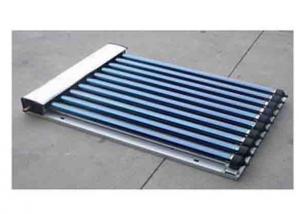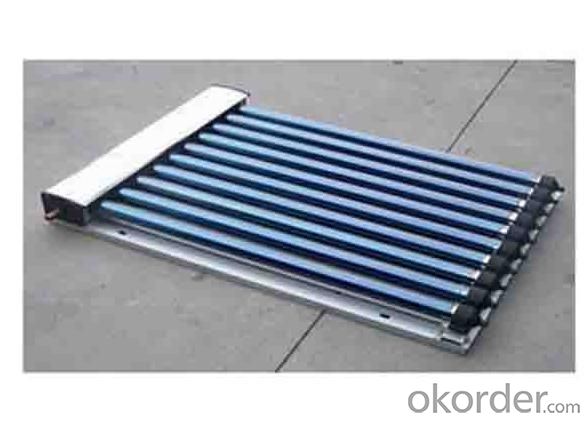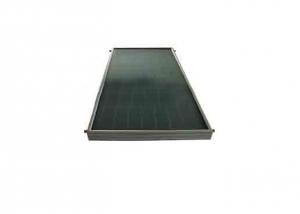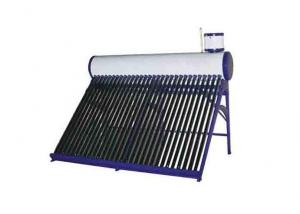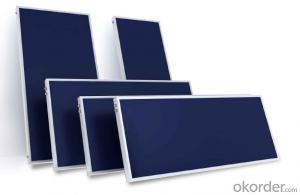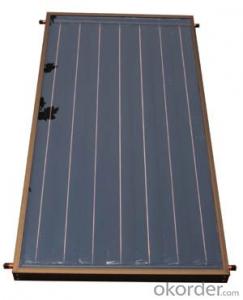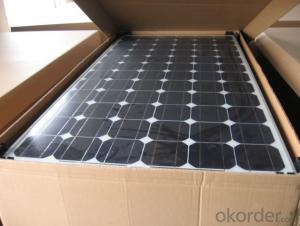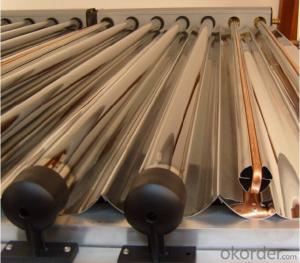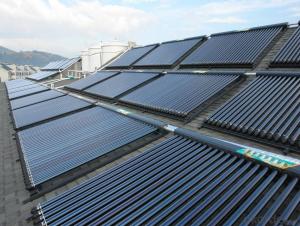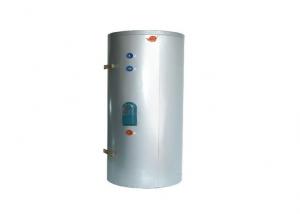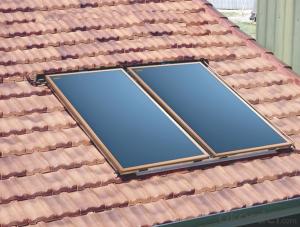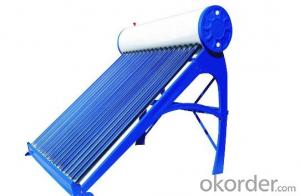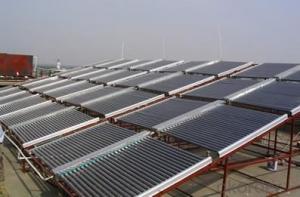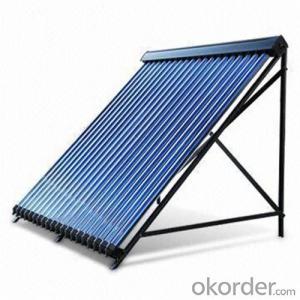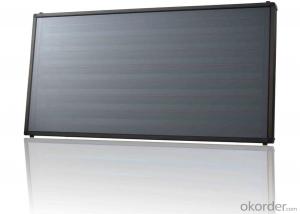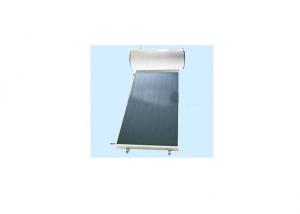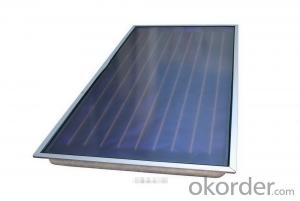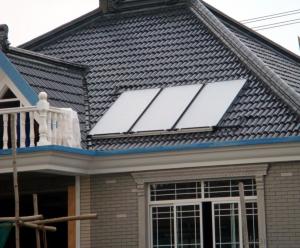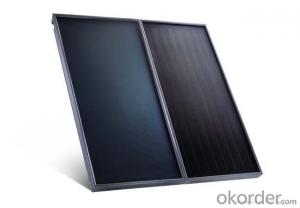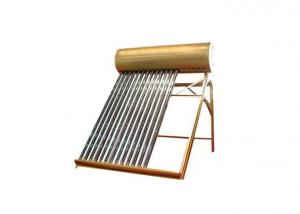Plastic Solar Collectors Split Pressurized Solar Water Heater
- Loading Port:
- China Main Port
- Payment Terms:
- TT or LC
- Min Order Qty:
- 2 Sets set
- Supply Capability:
- 180000 Sets per Year set/month
OKorder Service Pledge
OKorder Financial Service
You Might Also Like
*Heat collector
*Storage tank
*Working station kit
*Have own factory of vacuum tube
Working principle:
1) When the temperature of the heat collector reaches the set value, the controller will make shall the circulation pump work automatically.
2) The circulation pump makes heat-conducting liquid circulate automatically.
3) The heat-conducting liquid transfers heat to water by the heat exchanger in the tank.
4) In case the temperature of the circulation pump does not reach the set value, the circulation pump will be shut automatically.
5) In case the temperature of the tank does not reach Tm ax, then start the auxiliary heating device.
Feature:
*Collector separates with storage tank. The tank can be put in any place of house. And the collector can be put on the inclined roof or flat place.
*Module design, arbitrary combination, harmony with the building perfectly;
*Intelligent control and automatic operation;
*Anti-freeze: No water inside the tubes when it works.
*The system controller has the anti-freezing function is that the temperature circulation will operate while it reaches the fixed temperature.
*Multifunction: Bathing, washing, domestic heating etc;
*Work at anytime and enjoyable.
Structure:
Model No: 100L 150L 200L 300L
- Q: How much space is required for a solar collector installation?
- The space required for a solar collector installation varies depending on factors such as the size and type of collector, the desired energy output, and the location. Generally, a typical solar collector installation for residential use requires around 100 to 400 square feet of roof space. However, larger installations for commercial or industrial purposes may require significantly more space, often covering several acres. It is essential to consult with a solar professional to determine the specific space requirements for a particular installation.
- Q: Can solar collectors be used in combination with wastewater treatment systems?
- Yes, solar collectors can be used in combination with wastewater treatment systems. Solar collectors can be used to generate heat or electricity, which can be utilized in various stages of wastewater treatment processes. For example, solar thermal collectors can be used to heat the water in the treatment system, aiding in the removal of contaminants. Additionally, solar photovoltaic systems can be employed to generate electricity for powering the treatment facilities, making the process more sustainable and reducing reliance on traditional energy sources.
- Q: Do solar collectors require direct sunlight to function?
- No, solar collectors do not necessarily require direct sunlight to function. While direct sunlight is ideal for maximum efficiency, solar collectors can still generate electricity or heat water even on cloudy or overcast days. This is because solar collectors work by harnessing the energy from sunlight, which is composed of photons. These photons can still penetrate through clouds and reach the solar panels, allowing them to convert the sunlight into usable energy. However, it is important to note that the energy output will be lower on cloudy days compared to sunny days with direct sunlight.
- Q: How much energy can solar collectors generate?
- The amount of energy solar collectors can generate varies depending on several factors such as the size and efficiency of the collectors, the geographic location, and weather conditions. On average, a well-designed solar collector can generate around 1 to 2 kilowatt-hours (kWh) of electricity per square meter per day. However, it's important to note that with advancements in technology and larger installations, solar collectors have the potential to generate much more energy.
- Q: Are solar collectors suitable for all climates?
- Solar collectors are generally suitable for all climates, although their efficiency may vary depending on the amount of sunlight available. In regions with abundant sunlight, such as deserts, solar collectors can be highly effective. However, even in colder or cloudier climates, solar collectors can still provide a significant amount of energy. Additionally, advancements in technology have made solar collectors more adaptable to different weather conditions, making them a viable option in most climates.
- Q: Are there any government incentives or subsidies available for solar collectors?
- Yes, there are several government incentives and subsidies available for solar collectors. These incentives vary by country and region but commonly include tax credits, grants, rebates, and net metering programs. These initiatives aim to promote the adoption of renewable energy sources like solar power and make it more affordable for individuals and businesses to invest in solar collectors.
- Q: How do flat plate solar collectors work?
- Flat plate solar collectors work by capturing the sun's heat energy through a dark-colored plate, typically made of metal, which absorbs the sunlight. This absorbed heat is then transferred to fluid circulating through pipes or channels within the collector. The fluid, usually water or an antifreeze solution, then carries the heat to a storage tank or directly to a target application like space heating or hot water. The collector is designed with a transparent cover, usually glass or plastic, which allows sunlight to pass through but traps the heat inside, creating a greenhouse effect. This process allows flat plate solar collectors to efficiently convert solar energy into usable heat for various residential, commercial, and industrial purposes.
- Q: What is the typical installation process for solar collectors?
- Solar collectors are typically installed through a series of steps. Firstly, an assessment of the site is conducted to determine if it is suitable. Factors such as sunlight exposure, shading, and roof integrity are taken into account. Once the site is deemed suitable, the next step involves designing the solar collector system. This includes calculating the number of collectors needed based on energy requirements, designing the mounting system, and determining the best placement for the collectors. Following the design phase, the installation of the mounting system begins. This may involve attaching brackets or framework to the roof or ground, depending on the type of collectors being used. It is crucial to ensure that the mounting system is securely attached to withstand the weight of the collectors and potential weather conditions. Next, the solar collectors are installed onto the mounting system. This involves connecting the collectors to the brackets or framework and ensuring they are properly aligned and facing the sun for maximum efficiency. After the collectors are installed, the next step is to connect them to the property's electrical system. This typically involves installing wiring and a solar inverter, which converts the collected DC power into usable AC power. The inverter is usually connected to the property's main electrical panel for seamless integration. Finally, the installation process concludes with a thorough inspection and testing of the entire system to ensure it is functioning correctly and safely. This includes checking wiring connections, testing the output of the collectors, and verifying safety measures. Overall, the installation process for solar collectors requires careful planning, design, and execution for a successful and efficient system. It is advisable to hire an experienced professional to ensure a smooth and reliable installation.
- Q: What is the impact of snow on solar collector performance?
- The impact of snow on solar collector performance is generally negative as it can block sunlight from reaching the collectors, reducing their efficiency and overall energy output. With snow covering the surface of the solar panels, it prevents the absorption of sunlight, thus hindering the conversion of solar energy into electricity or heat. However, the impact can vary depending on the design of the collectors, angle of the panels, and the region's climate. Snow removal or tilt-adjustment of the panels are common strategies to mitigate the impact and ensure optimal performance.
- Q: How are solar collectors different from solar panels?
- Solar energy can be harnessed through the use of solar collectors and solar panels, although their purposes and functionalities differ. Solar collectors are specifically designed to capture and convert thermal energy from the sun into heat. These collectors are commonly used to heat water or air in residential, commercial, or industrial settings. They consist of tubes or pipes that circulate a heat transfer fluid, like water or antifreeze, absorbing the sun's heat and transferring it to a storage tank or directly to the desired application. Solar collectors are mainly utilized in solar water heating or space heating systems. On the other hand, solar panels, also known as photovoltaic (PV) panels, are used to directly convert sunlight into electricity. They are composed of multiple solar cells made of semiconductor materials, such as silicon, that generate electricity when exposed to sunlight. Solar panels are primarily used for generating electricity in residential, commercial, and utility-scale solar power systems. They can be mounted on rooftops, integrated into building materials, or installed as ground-mounted arrays. In conclusion, solar collectors are designed to capture and convert solar energy into heat, whereas solar panels are used to directly convert sunlight into electricity. Both technologies have important roles in harnessing solar energy and are employed in various applications to reduce reliance on conventional energy sources and promote sustainability.
1. Manufacturer Overview
| Location | Zhejiang, China |
| Year Established | 2004 |
| Annual Output Value | US$10 Million - US$50 Million |
| Main Markets | North America South America Eastern Europe Southeast Asia Africa Oceania Mid East Eastern Asia Western Europe |
| Company Certifications | ISO 9001:2000 ;CE ;Solar Keymark |
2. Manufacturer Certificates
| a) Certification Name | |
| Range | |
| Reference | |
| Validity Period |
3. Manufacturer Capability
| a) Trade Capacity | |
| Nearest Port | Shanghai,Ningbo |
| Export Percentage | 51% - 60% |
| No.of Employees in Trade Department | 6-10 People |
| Language Spoken: | English, Chinese |
| b) Factory Information | |
| Factory Size: | 10,000-30,000 square meters |
| No. of Production Lines | Above 10 |
| Contract Manufacturing | OEM Service Offered Design Service Offered Buyer Label Offered |
| Product Price Range | Average |
Send your message to us
Plastic Solar Collectors Split Pressurized Solar Water Heater
- Loading Port:
- China Main Port
- Payment Terms:
- TT or LC
- Min Order Qty:
- 2 Sets set
- Supply Capability:
- 180000 Sets per Year set/month
OKorder Service Pledge
OKorder Financial Service
Similar products
Hot products
Hot Searches
Related keywords
